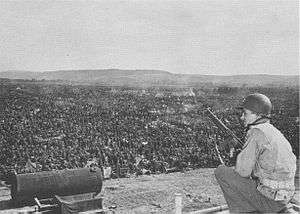Ruhr Pocket
| Ruhr Pocket | |||||||
|---|---|---|---|---|---|---|---|
| Part of World War II | |||||||
 An American soldier guards German prisoners captured in the Ruhr Pocket. | |||||||
| |||||||
| Belligerents | |||||||
|
(German resistance) |
| ||||||
| Commanders and leaders | |||||||
|
|
| ||||||
| Strength | |||||||
| c.300,000 | ~400,000 | ||||||
| Casualties and losses | |||||||
|
4,131 casualties (928 killed, 3,314 wounded) |
~400,000 casualties
| ||||||
The Ruhr Pocket was a battle of encirclement that took place in late March and early April 1945, near the end of World War II, in the Ruhr Area of Germany. It marked the end of major organized resistance on Nazi Germany's Western Front, as more than 300,000 troops were taken prisoner.
Background
In March 1945, the Allies crossed the River Rhine. South of the Ruhr, General Omar Nelson Bradley's U.S. 12th Army Group's pursuit of the disintegrating German army resulted in the capture of the Ludendorff Bridge across the Rhine at Remagen by the 9th Armored Division of the U.S. First Army. Bradley and his subordinates quickly exploited the crossing made on March 7, 1945, and expanded the bridgehead until the bridge collapsed 10 days later.
North of the Ruhr on March 23, 1945, Field Marshal Sir Bernard Montgomery's Anglo-Canadian 21st Army Group launched Operation Plunder (with the airborne Operation Varsity in support) and crossed the Rhine at Rees and Wesel.
Battle
Having crossed the Rhine, both Army groups fanned out into the German hinterland. In the south, while the Third Army headed east, the First Army headed northeast and formed the southern pincer of the Ruhr envelopment. In the north, the U.S. Ninth Army, which since the Battle of the Bulge had been assigned to Field Marshal Montgomery's 21st Army Group, headed southeast, forming the northern pincer, while the rest of the 21st Army Group went east and northeast.
Facing the Allied armies were the remnants of a shattered Wehrmacht, a few SS training units, and large numbers of Volkssturm (militia units for aging men, including some World War I veterans) and Hitlerjugend (Hitler Youth) units, composed of boys as young as 12.
Lead elements of the two Allied pincers met on April 1, 1945, near Lippstadt. By April 4, the encirclement was completed and the Ninth Army reverted to the command of General Bradley's 12th Army Group. Within the Ruhr Pocket about 430,000 German soldiers of Army Group B, which comprised 21 divisions of the Wehrmacht, and millions of civilians were trapped in cities heavily damaged by numerous bombings.
While the main operations headed further toward central and northern Germany, American forces concentrated on the pocket, taking it section by section. On April 12, 1945, the U.S. First and Ninth Armies divided the area coming from the south; the smaller, eastern part surrendered the next day. The western part continued a weak resistance until April 18 and April 21, 1945. Rather than surrender and violate his personal oath to Adolf Hitler that he would fight to the death, the commander, Field Marshal Walter Model, committed suicide in a forest south of the city of Duisburg, in Ratingen.
German anti-Nazi resistance groups in Düsseldorf attempted to surrender the city to the Allied armies in the so-called "Aktion Rheinland" in order to spare Düsseldorf from further destruction. However, SS units were able to crush the resistance, and executed a number of those involved. Executions of foreign labourers and political prisoners by the Gestapo had already been occurring since February. The act of resistance did accomplish a cancellation of further bombings on the city by another 800 bombers, through contact with the Americans. Düsseldorf was captured by Americans on 17 April without any notable fighting.
The surviving 325,000 German soldiers from the Ruhr Pocket, and some civilians, were imprisoned in the Rheinwiesenlager (in English, "Rhine meadow camp") near Remagen, a temporary prison enclosure.
References
- ↑ Zaloga, Steve, and Dennis, Peter (2006). Remagen 1945: endgame against the Third Reich. Oxford: Osprey Publishing. ISBN 1-84603-249-0. Page 87.
External links
- Ruhr Pocket End of war in Rhineland and Westphalia in April 1945.